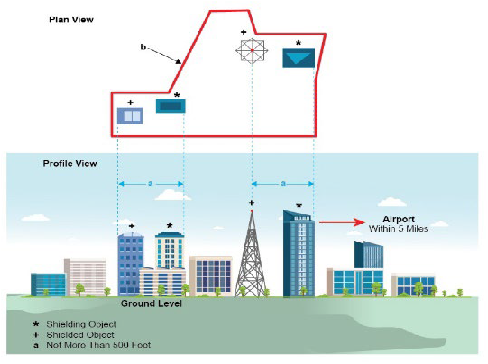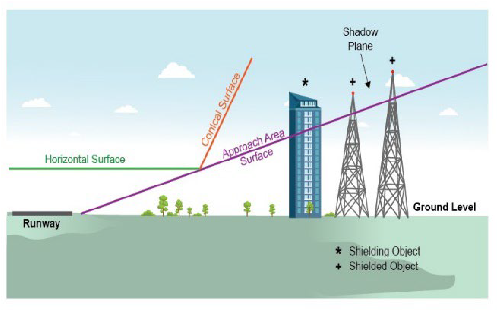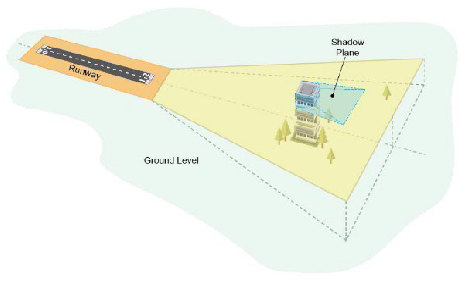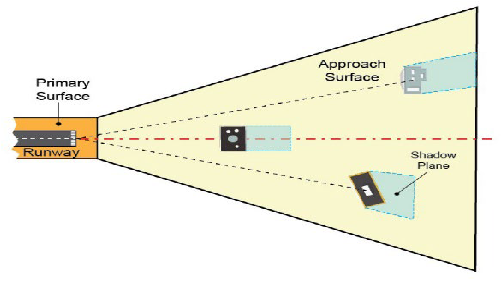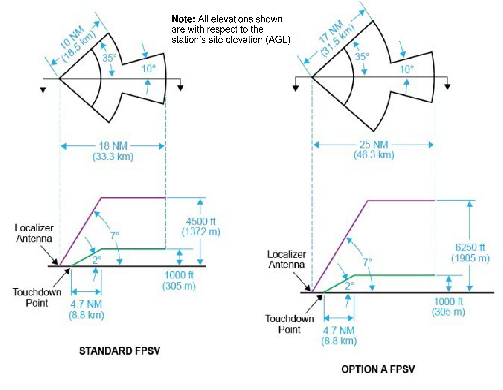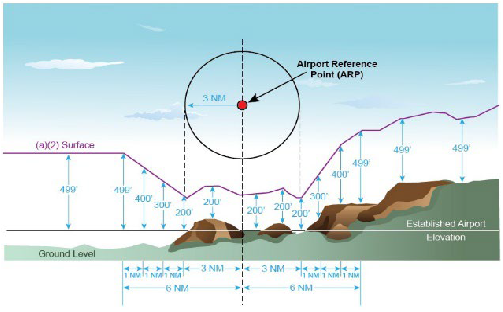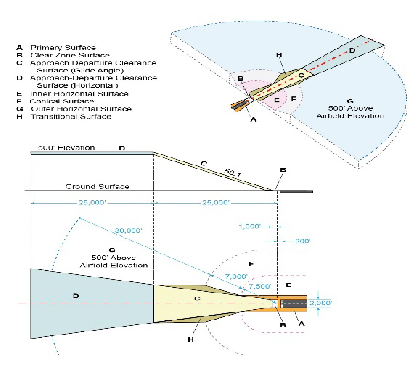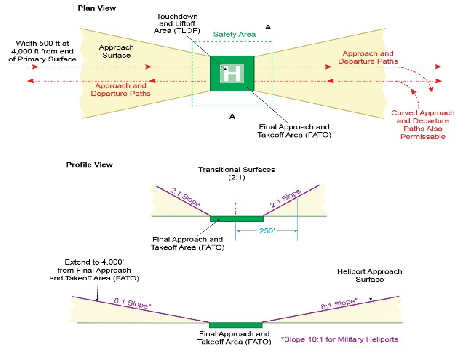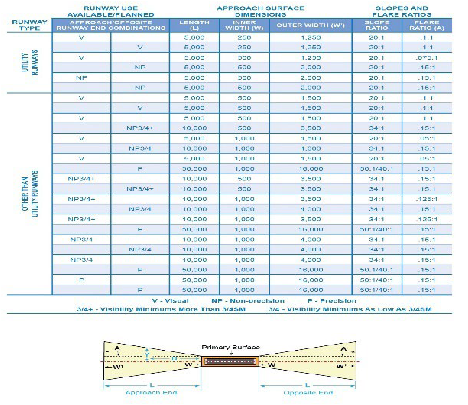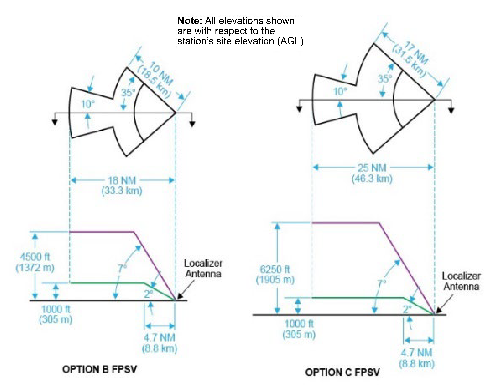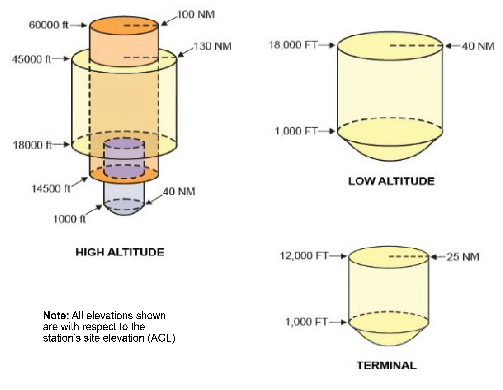Section 3. Identifying/Evaluating Aeronautical Effect
- The prime objective of the FAA in conducting OE/NRA studies is to ensure the safety of air navigation, and the efficient utilization of navigable airspace by aircraft. There are many demands being placed on the use of the navigable airspace. However, when conflicts arise concerning a structure being studied, the FAA emphasizes the need for conserving the navigable airspace for aircraft; preserving the integrity of the national airspace system; and protecting air navigation facilities and radar/surveillance facilities from either electromagnetic or physical encroachments that would preclude normal operation.
- In the case of such a conflicting demand for the airspace by a proposed construction or alteration, the first consideration should be given to altering the proposal.
- In the case of an existing structure, first consideration should be given to adjusting the aviation procedures to accommodate the structure. This does not preclude issuing a “Determination Of Hazard To Air Navigation” on an existing structure when the needed adjustment of aviation procedures could not be accomplished without a substantial adverse effect on aeronautical operations. In all cases, consideration should be given to all known plans on file received by the end of the public comment period or before issuance of a determination if the case was not circularized.
Part 77 establishes standards for determining obstructions to air navigation. A structure that exceeds one or more of these standards is presumed to be a hazard to air navigation unless the aeronautical study determines otherwise. An obstruction evaluation must identify:
- The effect the structure would have:
- On existing and proposed:
- Public-use airports, or;
- On FAA-approved instrument approach procedures at private-use airports, or;
- DoD airports and/or facilities.
- On existing and proposed visual flight rule (VFR)/instrument flight rule (IFR) aeronautical departure, arrival and en route operations, procedures, and minimum flight altitudes.
- Regarding physical, electromagnetic, or line-of-sight interference on existing or proposed air navigation, communications, radar/surveillance, and control systems facilities.
- On airport capacity, as well as the cumulative impact resulting from the structure when combined with the impact of other existing or proposed structures.
- Whether marking and/or lighting is necessary.
If a structure first exceeds the obstruction standards of 14 CFR part 77, and/or is found to have physical or electromagnetic radiation effect on the operation of air navigation and/or radar/surveillance, communications and weather facilities, then the proposed or existing structure, if not amended, altered, or removed, has an adverse effect if it would:
- Require a change to an existing or planned IFR minimum flight altitude, a published or special instrument procedure, or an IFR departure procedure.
- Require a VFR operation to change its regular flight course or altitude. This does not apply to VFR military training route (VR) operations, operations conducted under 14 CFR part 137, or operations conducted under an FAA-issued waiver or exemption.
- Restrict the clear view of runways, helipads, taxiways, or traffic patterns from the airport traffic control tower cab.
- Derogate airport capacity/efficiency.
- Affect future VFR and/or IFR operations as indicated by plans on file.
- Affect the usable length of an existing or planned runway.
OEG determines the volume of VFR/IFR activity, which must be considered in order to determine a significant volume of activity.
- Guidelines for significant volume of VFR activity would be, for example, if one or more aeronautical operations per day would be affected. This may indicate regular and continuing activity. Compressed geographical areas (that may include seasonal traffic) or other concentrations of VFR activity may also indicate regular and continuing activity and may be considered significant. This analysis is conducted by the OEG under the further study evaluation portion of the aeronautical study process.
- Guidelines for significant volume of activity for an affected instrument procedure or minimum IFR altitude may only need to be an average of once a week to be considered significant if the procedure is one which serves as the primary procedure under certain conditions.
A proposed structure would have, or an existing structure has, a substantial adverse effect if it causes electromagnetic interference to the operation of an air navigation or radar/surveillance facility or the signal used by aircraft, or if there is a combination of:
- Adverse effect as described in paragraph 6-3-3; and
- A significant volume of aeronautical operations, as described in paragraph 6-3-4, would be affected.
The FAA's obstruction evaluation program transcends organizational lines. In order to determine the effect of the structure within the required notice period, each office should forward the results of its evaluation within 15 working days to the Obstruction Evaluation Group (OEG) for further processing. In cases of evaluating the effects of a proposed wind turbine farm, see Appendix 12 for field air traffic control facility responsibility and procedures. Areas of responsibility are delegated as follows:
- OEG personnel must:
- Identify when the structure exceeds § 77.17 (a)(1), (a)(2), and (a)(5) (see FIG 6-3-1 thru FIG 6-3-6) and apply § 77.17 (b) (see FIG 5-2-4).
- Identify the effect on existing and planned aeronautical operations, air traffic control procedures, and airport traffic patterns and making recommendations for mitigating adverse effect including marking and lighting recommendations.
- Identify when the structure would adversely affect published helicopter route operations as specified in paragraph 6-3-8 subparagraph e, of this order, and forward the case to Flight Standards.
- Identify whether obstruction marking/lighting are necessary and recommend the appropriate marking and/or lighting.
- Identify when negotiations are necessary and conduct negotiations with the sponsor. This may be done in conjunction with assistance from other division/service area office personnel when their subject expertise is required (for example, in cases of electromagnetic interference).
- Identify when circularization is necessary and conduct the required circularization process.
- Evaluate all valid aeronautical comments received as a result of the circularization and those received as a result of the division evaluation.
- Issue the determination (except as noted in paragraph 7-1-2, subparagraph b).
- Regional Airports Division personnel must:
- Verify that the airport/runway database has been reviewed, is correct, and contains all plans on file pertaining to the OE case.
- Identify the structure's effect on existing and planned airports or improvements to airports concerning airport design criteria including potential restrictions/impacts on airport operations, capacity, efficiency and development, and making recommendations for eliminating adverse effect. Airports Divisions are not normally required to perform evaluations on:
- OE cases at non-federally obligated airports.
- At federally obligated airports, OE cases that are beyond the lateral limits of the part 77 conical surface.
NOTE-
Federally obligated airports are those that have federal obligations in the form of grant assurances, surplus and non-surplus obligations, or other applicable federal laws.
- Determine the effect on the efficient use of airports and the safety of persons and property on the ground. Airports will resist structures and activities that conflict with an airport's planning and/or design.
- Provide mitigations that may lessen or eliminate any adverse effect of the structure on existing or planned airports.
- IFP Service Providers must:
- Identify when the structure exceeds § 77.17(a)(3).
- Identify the effect upon terminal area IFR operations, including transitions; holding; instrument departure procedures; any segment of a Standard Instrument Approach Procedure (SIAP) or Special Instrument Approach Procedure (IAP), including proposed instrument procedures and departure areas.
- When applicable, include a “No Effect Height” (NEH) and/or survey accuracy that, if negotiated, would mitigate or eliminate adverse effect on an instrument flight procedure.
- IFP Service Providers. In addition to 6-3-6c, the IFP Service Providers must:
- Identify when the structure exceeds § 77.17(a)(4).
- Identify the effect on any IFR procedure which may include, but is not limited to: minimum en route altitudes (MEA); minimum obstruction clearance altitudes (MOCA); minimum IFR altitudes (MIA); minimum safe altitudes (MSA); minimum crossing altitudes (MCA); minimum holding altitudes (MHA); turning areas and termination areas; and making recommendations for eliminating adverse effect.
- Aeronautical Information Services' Obstacle Impact Team (OIT). In addition to 6-3-6c and d, the IFP OIT must identify the effect on any IFR procedure which may include minimum vectoring altitudes (MVA).
- Flight Standards (FS) personnel must identify adverse effects and possible mitigations for fixed-wing and helicopter VFR routes, terminal VFR operations, and other concentrations of VFR traffic (per paragraph 6-3-3, 6-3-4 and 6-3-8). All other potential issues of concern must be worked in consultation with the OEG to ensure applicability in accordance with all current agency directives.
- Technical Operations must identify electromagnetic and/or physical effect on public use navigation, radar/surveillance, communications and weather facilities and make recommendations for mitigating adverse effects, including:
- Airport traffic control tower line-of-sight visibility to runways, helipads, and taxiways from the air traffic control tower cab.
- The effect on the availability and/or quality of service for ground-based communications systems, including signals to/from the aircraft (e.g., RTR, RCAG or RCL).
- The effect on the availability and/or quality of service for visual navigational Systems (e.g., ALS or VGSI), communications equipment and ground-based terminal/ enroute navigation systems (e.g., ILS, VOR or DME).
- The effect on the availability or quality of ground-based primary and secondary radar/surveillance systems (e.g., ASR or ARSR) and airport surface detections systems (e.g., ASDE).
- The effect on the availability and/or quality of service for weather systems (e.g., ASOS or LLWAS).
- Military personnel are responsible for evaluating the effect on airspace and routes used by the military.
- Other applicable FAA offices or services may be requested to provide an evaluation of the structure on a case-by-case basis.
ANYWHERE
§ 77.17 - Obstruction Standards.
(a)(1) - A height of 499 feet AGL at the site of the object.
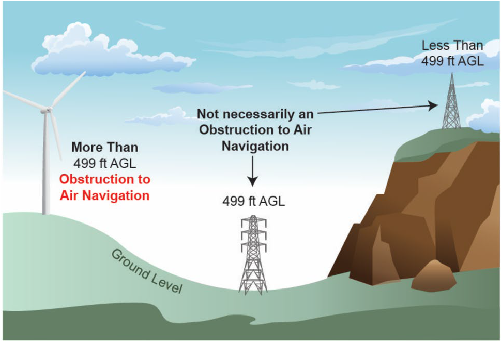
FIG 6-3-2
OBSTRUCTION STANDARDS NEAR AIRPORTS
Subpart C - Obstruction Standards
§ 77.17(a)(2) - An object would be an obstruction to air navigation if of greater height than 200 feet above ground at its site, or above the established airport elevation, whichever is higher-
(a) within 3NM of the established reference point of an airport with its longest runway more than 3,200 feet in actual length, and
(b) that height increases in proportion of 100 feet for each additional nautical mile from the airport reference point up to a maximum of 499 feet.
Note: Heliports excluded.
FIG 6-3-3
DEPARTMENT OF DEFENSE AIRPORT IMAGINARY SURFACES
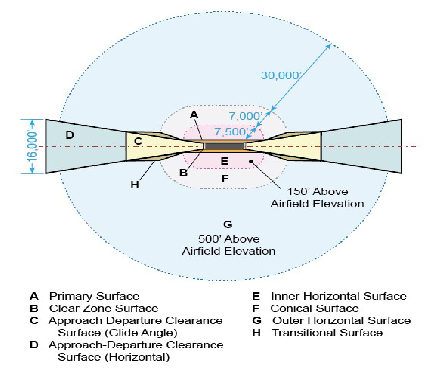
FIG 6-3-4
DEPARTMENT OF DEFENSE AIRPORT IMAGINARY SURFACES
FIG 6-3-5
DEPARTMENT OF DEFENSE AIRPORT SURFACES - CLEAR ZONE
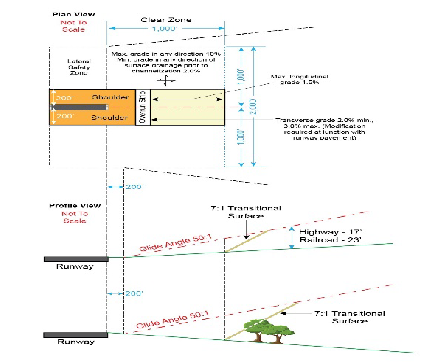
Sample Use Problem: Proposed structure would be located by measurement to be 20,000 feet from the end of primary surface and 3,400 feet at 90 from the extended centerline of a precision runway (refer to § 77.19(c) for relation of primary surface to end of runway). To determine whether it would fall within the approach surface of that runway, apply the following formula
Y = D x A + W/2
Y = distance for runway centerline to edge of the approach
D = distance from end of primary surface at which proposed construction is 90 from extended runway centerline
Y = 20,000 x 0.15 + 1000/2 Y = 3,000 + 500
Y = 3,500 (structure would be within approach surface)
- CIVIL AIRPORT SURFACES
- Civil airport imaginary surfaces are defined in § 77.19 and are based on the category of each runway according to the type of approach (visual, nonprecision, or precision) available or planned for each runway end (see FIG 6-3-7). The appropriate runway imaginary surface must be applied to the primary surfaces related to the physical end of the specific runway surface that is usable for either takeoff or landing.
- Approach Surface Elevation - Use the runway centerline elevation at the runway threshold and the elevation of the helipad as the elevation from which the approach surface begins (see §§ 77.19 and 77.23).
- Heliport imaginary surfaces are defined in § 77.23 and are based upon the size of the takeoff and landing area.
- Planned Airport/Runway Improvements - Consider the planned runway threshold and approach type when there is a plan on file with the FAA or with an appropriate military service to extend the runway and/or upgrade its use or type of approach. The existing runway threshold and type of approach may be used for temporary structures/equipment, as appropriate.
- DoD AIRPORT SURFACES - The obstruction standards in § 77.19, Civil Airport Imaginary Surfaces, apply to civil operated joint-use airports. The obstruction standards in § 77.21, DoD Airport Imaginary Surfaces, are applicable only to airports operated and controlled by a DoD service of the United States, regardless of whether use by civil aircraft is permitted.
- TERMINAL OBSTACLE CLEARANCE AREA - The terminal obstacle clearance area specified in § 77.17(a)(3) includes the initial, intermediate, final, and missed approach segments of an instrument approach procedure, and the circling approach and instrument departure areas. The applicable FAA approach and departure design criteria are contained in the FAA Order 8260 series.
- EN ROUTE OBSTACLE CLEARANCE AREA - The en route obstacle clearance area specified in § 77.17(a)(4) is applicable when evaluating the effect of a structure on an airway, a feeder route, and/or an approved off-airway route (direct route) as prescribed in the FAA Order 8260 series.
- PURPOSE. These guidelines are for use in determining the effect of structures, whether proposed or existing, upon VFR aeronautical operations in the navigable airspace. The intent of these guidelines is to provide a basis for analytical judgments in evaluating the effect of structures on VFR operations.
- CONSIDERATIONS
- Minimum VFR Flight Altitudes. Minimum VFR flight altitudes are prescribed by regulation. Generally speaking, from a VFR standpoint, the navigable airspace includes all airspace 500 feet AGL or greater and that airspace below 500 feet required for:
- Takeoff and landing, including the airport traffic pattern.
- Flight over open water and sparsely populated areas (an aircraft may not be operated closer than 500 feet to any person, vessel, vehicle, or structure).
- Helicopter operations when the operation may be conducted without hazard to persons and property on the surface.
- VFR Weather Minimums. Proposed or existing structures potentially have the greatest impact in those areas where VFR operations are conducted when ceiling and/or visibility conditions are at or near VFR weather minimums. Any structure that would interfere with a significant volume of low altitude flights (as determined by OEG) by actually excluding or restricting VFR operations in a specific area would have a substantial adverse effect and may be considered a hazard to air navigation.
- Marking and/or Lighting of Structures. Not every structure penetrating the navigable airspace is considered to be a hazard to air navigation. Some may be marked and/or lighted so pilots can visually observe and avoid the structures. OEG determines the marking and/or lighting of a structure (FS may be consulted on a case-by-case basis).
- Shielded Structures. A structure may be “shielded” by being located in proximity to other permanent structures or terrain and would not, by itself, adversely affect aeronautical operations (see paragraph 6-3-13).
- Height of Structures. Structures are of concern to pilots during a climb after takeoff, low altitude operations, and when descending to land. Any structure greater than 499 feet AGL, or structures of any height which would affect landing and takeoff operations, requires extensive evaluation to determine the extent of adverse effect on VFR aeronautical operations.
- Airport Traffic Patterns. The primary concern regarding structures in airport traffic pattern areas is whether they would create a dangerous situation during a critical phase of flight.
- Class B and C Airspace. Structures that exceed obstruction standards in areas available for VFR flight below the floor of Class B or C airspace areas require careful evaluation. Class B and C airspace areas are designed to provide a more regulated environment for IFR and VFR traffic in and around certain airports. Consequently, the floors of some Class B and C areas compress VFR operations into airspace of limited size and minimum altitude availability.
-
VFR Routes. The Obstruction Evaluation Group (OEG), in coordination with Flight Standards, will identify and evaluate VFR routes that may be impacted by a proposal. VFR pilots frequently utilize a combination of navigation techniques such as pilotage, dead reckoning, ground-based navigation, and Area Navigation (RNAV) using Global Positioning Systems (GPS). VFR pilots may fly routes that follow easily identifiable surface features such as rivers, coastlines, bodies of water, mountain passes, valleys, major highways, railroads, powerlines, canals, and other manmade structures. Other concentrations of VFR traffic (VFR route) can also be discovered by reviewing traffic data when the OEG conducts the further study portion of the aeronautical study process. Examples are depicted in Figure 6-3-8, VFR Routes.
Each identified VFR Route or other concentrations of VFR activity will be evaluated independently.
- EN ROUTE OPERATIONS. The area considered for en route VFR flight begins and ends outside the airport traffic pattern airspace area or Class B, C, and D airspace areas.
- A structure would have an adverse effect upon VFR air navigation if its height is greater than 499 feet above the surface at its site, and within 2 statute miles of any regularly used VFR route (see FIG 6-3-8).
- Evaluation of obstructions located within VFR routes must recognize that pilots may, and sometimes do, operate below the floor of controlled airspace during low ceilings and 1 statute mile flight visibility. When operating in these weather conditions and using pilotage navigation, these flights must remain within 1 statute mile of the identifiable landmark to maintain visual reference. Even if made more conspicuous by the installation of high intensity white obstruction lights, a structure placed in this location could be a hazard to air navigation because after sighting it, the pilot may not have the opportunity to safely circumnavigate or overfly the structure.
- VFR DoD TRAINING ROUTES (VR) - Operations on VRs provide DoD aircrews with low altitude, high-speed navigation and tactics training, and are a basic requirement for combat readiness (see FAA Order JO 7610.14, Non-Sensitive Procedures and Requirements for Special Operations). Surface structures have their greatest impact on VFR operations are based on consideration for those operations conducted under 14 CFR part 91 that permits flight clear of clouds with 1 statute mile flight visibility outside controlled airspace. In contrast, flight along VRs can be conducted only when weather conditions equal or exceed 3,000 feet ceiling and 5 miles visibility. A proposed structure's location on a VR is not a basis for determining it to be a hazard to air navigation; however, in recognition of the DoD's requirement to conduct low altitude training, disseminate 14 CFR part 77 notices and aeronautical study information to DoD representatives. Additionally, attempt to persuade the sponsor to lower or relocate a proposed structure that exceeds obstruction standards and has been identified by the DoD as detrimental to its training requirement.
- AIRPORT AREAS - Consider the following when determining the effect of structures on VFR operations near airports:
- Traffic Pattern Airspace - There are many variables that influence the establishment of airport arrival and departure traffic flows. Structures in the traffic pattern airspace may adversely affect air navigation by being a physical obstruction to air navigation or by distracting a pilot's attention during a critical phase of flight. The categories of aircraft using the airport determine airport traffic pattern airspace dimensions.
NOTE-
Traffic Pattern Airspace is for both arrivals and departures. The considerations and calculations must account for both. Although called “approach” slope or surface, the intent is to ensure adequate airspace is provided, including additional safety margins, for aircraft operations both during landing and taking off. Consequently, this could be thought of as approach and departure slope/surface. This is not the same and should not be confused with the IFR Departure Surface.
- Traffic Pattern Airspace dimensions (See FIG 6-3-9).
NOTE-
Airspace dimensions are defined in both lateral and vertical terms. Traffic pattern airspace, however, has no vertical component (i.e., no altitude). Therefore, any structure, terrain, nature growth, etc. within the lateral dimensions shown in FIG 6-3-9 is within this airspace, no matter the height.
- Within Traffic Pattern Airspace - A structure that exceeds a 14 CFR, part 77 obstruction standard and that exceeds any of the following heights is considered to have an adverse effect and would have a substantial adverse effect if a significant volume of VFR aeronautical operations are affected except as noted in paragraph 6-3-8 d.1.(f) and (g) (see FIG 6-3-10).
- The height of the transition surface (other than abeam the runway), the approach slope (up to the height of the horizontal surface), the horizontal surface, and the conical surface (as applied to visual approach runways, § 77.19).
- Beyond the lateral limits of the conical surface and in the climb/descent area - 350 feet above airport elevation or the height of 14 CFR § 77.17(a)(2), whichever is greater not to exceed 499 feet above ground level (AGL). The climb/descent area begins abeam the runway threshold being used and is the area where the pilot is either descending to land on the runway or climbing to pattern altitude after departure. (The area extending outward from a line perpendicular to the runway at the threshold, see FIG 6-3-11).
- Beyond the lateral limits of the conical surface and not in the climb/descent area of any runway - 499 feet above airport elevation (AE) not to exceed 499 feet AGL.
- An existing structure (that has been previously studied by the FAA), terrain, or a proposed structure (that would be shielded by existing structures) may not be considered to have a substantial adverse effect. In such instances, the traffic pattern may be adjusted as needed on a case-by-case basis.
- Exceptions may be made on a case-by-case basis when the surrounding terrain is significantly higher than the airport elevation, the established traffic pattern altitude is less than 800 feet above airport elevation or “density altitude” is a consideration.
- Terminal Transition Routes - A structure would have an adverse effect upon VFR air navigation if it:
- Exceeds a height of 499 feet above the surface at its site; and
- Is located within 2 statute miles of the centerline of any regularly used VFR route (see FIG 6-3-8).
- VFR Approach/Departure Surface Slope Ratios - A structure would have an adverse effect upon VFR air navigation if it penetrates the surface slope of any runway. The following slope ratios are applied to the end of the primary surface:
- 20:1 for civil visual.
- 50:1 for DoD runways.
- 8:1 for civil helicopter surfaces.
- 10:1 for DoD helicopter surfaces.
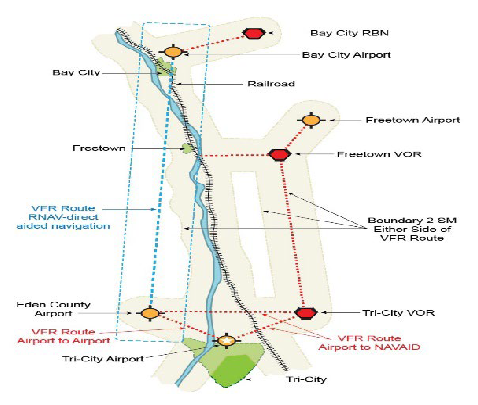
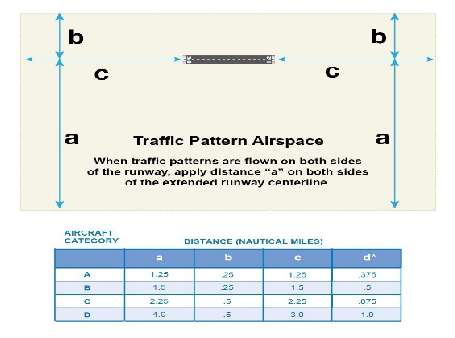
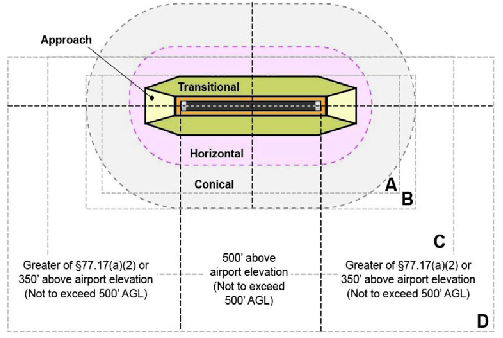
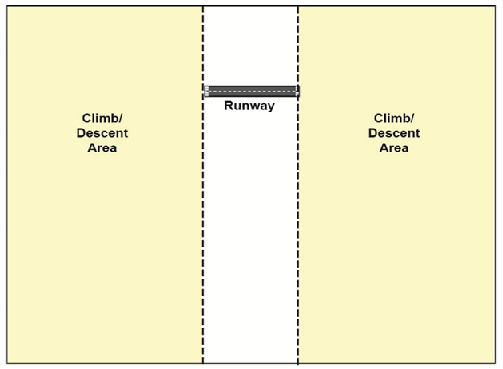
- HELICOPTERS - The special maneuvering characteristics of helicopters are recognized in §§ 91.119 and 91.155, provided operations are conducted without hazard to persons or property on the ground. Helicopter pilots must also operate at a speed that will allow them to see and avoid obstructions. Consequently, proposed or existing structures are not considered factors in determining adverse effect upon helicopter VFR operations except as follows:
- En route. When the Administrator prescribes routes and altitudes for helicopters, the exemptions to part 91 for helicopters do not apply. Thus, any structure would have an adverse effect if it penetrates an imaginary surface 300 feet below an established helicopter minimum flight altitude and is located within 250 feet either side of the established route's centerline.
- Heliport Landing/Takeoff Area. Any structure would have an adverse effect if it would exceed any of the heliport imaginary surfaces. Although helicopter approach-departure paths may curve, the length of the approach-departure surface remains fixed.
- AGRICULTURAL AND INSPECTION AIRCRAFT OPERATIONS - Visual flight rules that apply to agricultural dispensing operations, as prescribed in part 137, allow deviation from part 91 altitude restrictions. It is the pilot's responsibility to avoid obstacles because the agricultural operations must be conducted without creating a hazard to persons or property on the surface. Similar operations include pipeline, power line, military low-level route inspections, aerial fire-fighting, emergency response, and other types of low altitude flight operations in accordance with a Flight Standards waiver. Consequently, these operations are not considered in reaching a determination of substantial adverse effect.
NOTE-
When agricultural aircraft are flying en route, before and after the dispensing is completed, those VFR operations are considered.
- OPERATIONS UNDER WAIVER OR EXEMPTION TO CFR - Waivers and/or exemptions to CFR operating rules include provisions to ensure achievement of a level of safety equivalent to that which would be present when complying with the regulation waived or exempted. Additionally, waivers and exemptions do not relieve pilots of their responsibility to conduct operations without creating a hazard to persons and property on the surface. Accordingly, a determination of hazard to air navigation must not be based upon a structure's effect on aeronautical operations conducted under a waiver or exemption to CFR operating rules.
- PURPOSE. This section provides general guidelines for determining the effect of structures, whether proposed or existing, upon IFR aeronautical operations.
- STANDARDS. Obstruction standards are used to identify potential adverse effects and are not the basis for a determination. The criteria used in determining the extent of adverse affect are those established by the FAA to satisfy operational, procedural, and electromagnetic requirements. These criteria are contained in regulations, advisory circulars, and orders (for example, the FAA Order 8260 series and FAA Order JO 7110.65). Obstruction evaluation personnel must apply these criteria in evaluating the extent of adverse effect to determine if the structure being studied would actually have a substantial adverse effect and would constitute a hazard to air navigation.
- MINIMUM ALTITUDE FOR IFR OPERATIONS. Aeronautical Information Services Technical Operations Aviation System Standards is the principal FAA element responsible for establishing instrument procedures and minimum altitudes for IFR operations. FPT personnel must evaluate the effect of proposed structures on IFR aeronautical operations as outlined in Order 8260.19, Flight Procedures and Airspace.
- EN ROUTE IFR OPERATIONS
- Minimum En Route Altitude (MEA). MEAs are established for each segment of an airway or an approved route based upon obstacle clearance, navigational signal reception, and communications. The MEA assures obstruction clearance and acceptable navigational signal coverage over the entire airway or route segment flown. Any structure that will require an MEA to be raised has an adverse effect. Careful analysis by the appropriate IFP Service Provider and air traffic personnel is necessary to determine if there would be a substantial adverse effect on the navigable airspace. Generally, the loss of a cardinal altitude is considered a substantial adverse effect. However, the effect may not be substantial if the aeronautical study discloses that the affected MEA is not normally flown by aircraft, nor used for air traffic control purposes
- Minimum Obstruction Clearance Altitude (MOCA). MOCAs assure obstacle clearance over the entire route segment to which they apply and assure navigational signal coverage within 22 NM of the associated VOR navigational facility. For that portion of the route segment beyond 22 NM from the VOR, where the MOCA is lower than the MEA and there are no plans to lower the MEA to the MOCA, a structure that affects only the MOCA would not be considered to have substantial adverse effect. Other situations require study as ATC may assign altitudes down to the MOCA under certain conditions.
- Minimum IFR Altitude (MIA) Sector Charts. These altitudes are established in accordance with FAA Order 7210.37, En Route Instrument Flight Rules (IFR) Minimum IFR Altitude (MIA) Sector Charts, to provide the controller with minimum IFR altitude information for off-airway operations. MIAs provide the minimum obstacle clearance and are established without respect to flight-checked radar or normal radar coverage. Any structure that would cause an increase in a MIA is an obstruction, and further study is required to determine the extent of adverse effect. Radar coverage adequate to vector around such a structure is not, of itself, sufficient to mitigate a finding of substantial adverse effect that would otherwise be the basis for a determination of hazard to air navigation.
- IFR Military Training Routes (IRs) - Operations on IR's provide pilots with training for low altitude navigation and tactics (see FAA Order JO 7610.14, Non-Sensitive Procedures and Requirements for Special Operations). Flight along these routes can be conducted below the minimum IFR altitude specified in part 91, and the military conducts operational flight evaluations of each route to ensure compatibility with their obstructions clearance requirements. A proposed structure's location on an IR is not a basis for determining it to be a hazard to air navigation; however, in recognition of the military's requirement to conduct low altitude training, disseminate part 77 notices and aeronautical study information to military representatives. Additionally, attempt to persuade the sponsor to lower, or relocate proposed structures that exceed obstruction standards and have been identified by the military as detrimental to their training requirement.
- Radar Bomb Sites (RBS) - These sites are a vital link in the low level training network used by the U.S. Air Force to evaluate bomber crew proficiency. They provide accurate radar records for aircraft flying at low altitudes attacking simulated targets along the RBS scoring line. An obstruction located within the flights' RBS boundaries may have a substantial adverse effect and a serious operational impact on military training capability.
- TERMINAL AREA IFR OPERATIONS. The obstruction standards contained in 14 CFR part 77 are also used to identify obstructions within terminal obstacle clearance areas. Any structure identified as an obstruction is considered to have an adverse effect; however, there is no clear-cut formula to determine what extent of adverse effect is considered substantial. Instrument approach and departure procedures are established in accordance with published obstacle clearance guidelines and criteria. However, there are segments of instrument approach procedures where the minimum altitudes may be revised without substantially effecting landing minimums. Thus, the determination must represent a decision based on the best facts that can be obtained during the aeronautical study.
- Standard Instrument Approach Procedures (SIAP) and/or Special IAPs at public and private‐use airports. IFP Service Providers are responsible for evaluating the effect of structures upon any segment of, or departure restriction associated with, any FAA‐approved procedure they maintain. However, all personnel involved in the obstruction evaluation process should be familiar with all aspects of the terminal area IFR operations being considered. If any IFP Service Provider determines a structure will affect instrument flight procedures, their evaluation should include the NEH based on the filed Accuracy Code. Include an NEH and/or survey accuracy that, if negotiated, would mitigate or eliminate adverse effect on an instrument flight procedure.
- Minimum Vectoring Altitudes (MVA). These altitudes are based upon obstruction clearance requirements only (see FAA Order 8260 series and Order JO 7210.3, Facility Operation and Administration). The area considered for obstacle clearance is the normal operational use of the radar without regard to the flight-inspected radar coverage. It is the responsibility of individual controllers to determine that a target return is adequate for radar control purposes. MVAs are developed by terminal facilities, approved by the Terminal Procedures and Charting Group and published for controllers on MVA Sector Charts. Any structure that would cause an increase in an MVA is an obstruction and a study is required to determine the extent of adverse effect. Radar coverage adequate to vector around such a structure is not, of itself, sufficient to mitigate a finding of substantial adverse effect that would otherwise be the basis for a determination of hazard to air navigation.
- Military Airports. The appropriate military commands establish and approve terminal instrument procedures for airports under their respective jurisdictions. Consequently, the OEG must ensure that the military organizations are provided the opportunity to evaluate a structure that may affect their operations. While the military has the responsibility for determining the effect of a structure, it is expected that the FPT will assist air traffic in reconciling differences in the military findings.
- Departure Procedures. FAA Order 8260.58, United States Standard for Performance Based Navigation (PBN) Instrument Procedure Design, and other FAA 8260 series orders contain criteria for the development of IFR departure procedures. An obstacle that penetrates the 40:1 departure slope is considered to be an obstruction to air navigation. Further study is required to determine if adverse effect exists. Any proposed obstacle that penetrates the 40:1 departure slope, originating at the departure end of runway (DER) by up to 35 feet will be circularized. If an obstacle penetrates the 40:1 departure slope by more than 35 feet, it is presumed to be a hazard, and a Notice of Preliminary Findings will be issued, and processed accordingly. Analysis by OEG and air traffic personnel is necessary to determine if there would be a substantial adverse effect on the navigable airspace.
- Minimum Safe Altitudes (MSA) and Emergency Safe Altitude (ESA).
- MSAs and ESAs are designed for emergency use only and are not routinely used by pilots or by air traffic control. They are not considered a factor in determining the extent of adverse effect, used as the basis of a determination, or addressed in the public notice of an aeronautical study.
- An MSA is the minimum obstacle clearance altitude for emergency use within 25 NM of an omnidirectional navigation facility, waypoint, or location ID for airport reference point upon which the MSA is predicated.
- An ESA is established within a 100-mile radius of a navigation facility and normally found only on military procedures at the option of the approval authority.
- CONSIDERING ACCURACY. Experience has shown that submissions often contain elevation and/or location errors. For this reason, the IFP Service Providers use vertical and horizontal accuracy adjustments, as reflected below, to determine the effect on IFR operations.
- Accuracy Application - FAA Order 8260.19 requires the IFP Service Provider to apply accuracy standards to obstacles when evaluating effects on instrument procedures. These accuracy standards typically require an adjustment of 50 feet vertically and 250 feet horizontally to be applied in the most critical direction. Normally, these adjustments are applied to those structures that may become the controlling obstructions and are applicable until their elevation and location are verified by survey.
- Certified Accuracy - The IFP Service Provider must notify OEG whenever certified accuracy would lessen the adverse effect upon IFR procedures. The OEG will review and determine whether to request a surveyed verification of the elevation and location. The acceptable accuracy verification method must be provided and certified by a licensed engineer or surveyor. The survey must include the plus or minus accuracy required, as well as the signature of the engineer/surveyor and the appropriate seal.
- Determination - A final determination based on improved accuracy must not be issued until after the certified survey is received and evaluated by the OEG.
- Survey Information Distribution - When the certified survey is received, OEG personnel must ensure that the survey information is uploaded into the OE/AAA system and change the accuracy code within the study as appropriate.
- The FAA is authorized to establish, operate, and maintain air navigation, radar/surveillance, and communications facilities and to protect such facilities from interference. During the evaluation of structures, factors that may adversely affect any portion or component of the NAS must be considered. Since an electromagnetic interference potential may create adverse effects as serious as those caused by a physical penetration of the airspace by a structure, those effects must be identified and stated. Proposals will be handled, when appropriate, directly with FCC through Technical Operations Spectrum Engineering Services Group/Spectrum Assignment and Engineering Team.
- Technical operations personnel must evaluate notices to determine if the structure will affect the performance of existing or proposed NAS facilities. The study must also include any plans for future facilities, proposed airports, or improvements to existing airports.
- The physical presence of a structure and/or the electromagnetic signals emanating or reflecting there from may have a substantial adverse effect on the availability, or quality of navigational, radar/surveillance, and communications signals, or on air traffic services needed for the safe operation of aircraft. The following general guidelines are provided to assist in determining the anticipated interference.
- Instrument Landing System (ILS) - Transmitting antennas are potential sources of electromagnetic interference that may effect the operation of aircraft using an ILS facility. The antenna height, radiation pattern, operating frequency, effective radiated power (ERP), and its proximity to the runway centerline are all factors contributing to the possibility of interference. Normally, any structure supporting a transmitting antenna within the established localizer and/or glide-slope service volume area must be studied carefully. However, extremes in structure height, ERP, frequency, and/or antenna radiation pattern may require careful study of structures up to 30 NM from the ILS frequency's protected service volume area.
- ILS Localizer. Large mass structures adjacent to the localizer course and/or antenna array are potential sources of reflections and/or re-radiation that may affect facility operation. The shape and intensity of such reflections and/or re-radiation depends upon the size of the reflecting surface and distance from the localizer antenna. The angle of incidence reflection in the azimuth plane generally follows the rules of basic optical reflection. Normally, in order to affect the course, the reflections must come from structures that lie in or near the on-course signal. Large mass structures of any type, including metallic fences or powerlines, within plus/minus 15 degrees of extended centerline up to 1 NM from the approach end of the runway and any obstruction within 500 feet of the localizer antenna array must be studied carefully. (Refer to FAA Order 6750.16, Siting Criteria for Instrument Landing Systems).
- ILS Glide Slope. Vertical surfaces within approximately 1,000 feet of the runway centerline and located up to 3,000 feet forward of the glide slope antenna can cause harmful reflections. Most interference to the glide slope are caused by discontinuities in the ground surface, described approximately as a rectangular area 1,000 feet wide by 5,000 feet long, extending forward from the glide slope antenna and centered at about the runway centerline. Discontinuities are usually in the form of rough terrain or buildings (refer to FAA Order 6750.16, Siting Criteria for Instrument Landing Systems).
- Very High Frequency Omni-Directional Radio Range and Tactical Air Navigation Aid (VOR/TACAN). Usually, there should be no reflecting structures or heavy vegetation (trees, brush, etc.) within a 1,000 foot radius of the VOR or the TACAN antenna. Interference may occur from large structures or powerlines up to 2 NM from the antenna. Wind turbines are a special case, in that they may cause interference up to 8 NM from the antenna. (Refer to FAA Order 6820.10, VOR, VOR/DME, and TACAN Siting Criteria).
- Air Route Surveillance Radar/Airport Surveillance Radar (ARSR/ASR). Normally, there should be no reflecting structures within a 1,500-foot radius of the radar antenna. In addition, large reflective structures up to 3 NM from the antenna can cause interference unless they are in the “shadow” of topographic features. Wind turbines are a special case, in that they may cause interference up to the limits of the radar line of site.
- Air Traffic Control Radar Beacon (ATCRB). The effects encountered due to reflections of the secondary radar main lobe are more serious than those associated with primary radar. Therefore, it is necessary to ensure that no large vertical reflecting surface penetrates a 1,500-foot radius horizontal plane located 25 feet below the antenna platform. In addition, interference may occur from large structures up to 12 miles away from the antenna. This distance will depend on the area of the reflecting surface, the reflection coefficient of the surface, and its elevation with respect to the interrogator antenna. (Refer to FAA Order 6310.6, Primary/Secondary Terminal Radar Siting Handbook).
- Directional Finder (DF). The DF antenna site should be free of structures that will obstruct line-of-sight with aircraft at low altitudes. The vicinity within 300 feet of the antenna should be free of metallic structures which can act as re-radiators.
- Communication Facilities. Minimum desirable distances to prevent interference problems between communication facilities and other construction are:
- 1,000 feet from power transmission lines (other than those serving the facility) and other radio or radar facilities.
- 300 feet from areas of high vehicle activity such as highways, busy roads, and large parking areas.
- One (1) NM from commercial broadcasting stations (e.g., FM, TV).
- Approach Lighting System. No structure, except the localizer antenna, the localizer far field monitor antenna, or the marker antenna must protrude above the approach light plane. For approach light plane clearance purposes, all roads, highways, vehicle parking areas, and railroads must be considered as vertical solid structures. The clearance required above interstate highways is 17 feet; above railroads, 23 feet; and for all other public roads, highways, and vehicle parking areas, 15 feet. The clearance required for a private road is 10 feet or the highest mobile structure that would normally use the road, which would exceed 10 feet. The clearance for roads and highways must be measured from the crown of the road; the clearance for railroads must be measured from the top of the rails. For vehicle parking areas, clearance must be measured from the average grade in the vicinity of the highest point. Relative to airport service roads substantial adverse effect can be eliminated if all vehicular traffic is controlled or managed by the air traffic control facility. A clear line-of-sight is required to all lights in the system from any point on a surface, one-half degree below the aircraft descent path and extending 250 feet each side of the runway centerline, up to 1,600 feet in advance of the outermost light in the system. The effect of parked or taxiing aircraft must also be considered when evaluating line-of-sight for approach lighting systems.
- Visual Approach Slope Indicator (VASI)/Precision Approach Path Indicator (PAPI). No structures or obstructions must be placed within the clearance zone for the particular site involved or the projected visual glide path.
NOTE-
VASI and PAPI now fall under the heading of VGSI.
- Runway End Identifier Lights (REIL). No structures or obstructions must be placed within the established clearance zone.
- Factors that modify the evaluation criteria guidelines require consideration. Some facility signal areas are more susceptible to interference than others. The operational status of some signals may already be marginal because of existing interference from other structures. In addition, the following characteristics of structures must be considered:
- The higher the structure's height is in relation to the antenna, the greater the chance of interfering reflections. Any structure subtending a vertical angle greater than one degree from the facility is usually cause for concern. Tall structures, such as radio towers and grain elevators, can interfere from distances greater than those listed in the general criteria.
- The type of construction material on the reflecting surface of the structure is a factor, with nonmetallic surfaces being less troublesome than metallic or metallic impregnated glass.
- Aircraft hangars with large doors can be a special problem because the reflecting surface of the hangar varies appreciably with changes in the position of the doors.
- Interference is usually caused by mirror reflections from surfaces on the structure. Orientation of the structure therefore plays an important part in the extent of the interference. Reflections of the largest amplitude will come from signals striking a surface perpendicular to the signals. Signals striking a surface at a shallow angle will have a smaller amplitude.
- Air traffic personnel must request technical operations personnel to assist them in discussions with sponsors to explore alternatives to resolve the prospective adverse effects to facilities. These may involve design revisions, relocation, or reorientation depending on the character of the construction and facility involved.
- Attempt to resolve electromagnetic interference (EMI) before issuing a hazard determination. Notify the sponsor by letter (automated DPH letter) that the structure may create harmful EMI and include in the letter the formula and values that were applied, the specific adverse effects expected, and an offer to consider alternatives. Provide the sponsor, as well as the FAA, ample time to exhaust all available avenues for positive resolution. The intent of this process is to allow the sponsor adequate time to consider the problems and the alternatives before a decision is rendered by the issuance of the FAA determination. Follow these guidelines in all situations where harmful EMI is projected by the study.
The national system of airports consists of public, civil, and joint-use airport facilities considered necessary to adequately meet the anticipated needs of civil aeronautics. Airport Planning and Programming FAA Airports District Offices (ADO) are the most accurate source of up-to-date information on airport development plans and Airport Layout Plans (ALP). Consequently, Airports personnel are expected to extensively review structures in reference to the safe and orderly development of airport facilities. Areas of consideration in accomplishing this responsibility are:
- Future Development of Existing Airports. Review in this area requires looking at current planned airport projects, national airport plan data, and land-use planning studies in the vicinity of the structure via the review of the ALP. If a structure would adversely impact an airport's efficiency, utility, or capacity, the responsible Airports Office should document this impact in its evaluation. Comments should include recommended new location(s) for the structure as appropriate.
- New Airport Development. When a structure requiring notice under 14 CFR part 77 and any new airport development are both in the same vicinity, Airports personnel must study the interrelationship of the structure and the airport. If a substantial adverse effect is anticipated, Airports personnel must provide detailed comments and specific recommendations for mitigating the adverse effects.
- Temporary Construction Equipment. Construction of structures normally requires use of temporary construction equipment that is of a greater height than the proposed structure. Appropriate action is necessary to ensure that the temporary construction equipment does not present a hazard to air navigation. It is not possible to set forth criteria applicable to every situation; however, the following action examples may help to minimize potential problems:
- The use of temporary construction equipment may necessitate negotiation with airport managers/owners to close a runway, taxiway, temporarily move a runway threshold, or take other similar actions.
- Negotiate with equipment operators to raise and lower cranes, derricks, or other construction equipment when weather conditions go below predetermined minimums as necessary for air traffic operations or as appropriate for the airport runways in use.
- Control the movement of construction vehicle traffic on airports.
- Adjust minimum IFR altitudes or instrument procedures as necessary to accommodate the construction equipment if such action will not have serious adverse effects on aeronautical operations.
- Request that the temporary construction equipment be properly marked and/or lighted if needed.
- Temporary Structures - OE notices for temporary structures are processed in the same manner as a permanent structure, but require special consideration in determining the extent of adverse effect. This is especially true of structures such as cranes and derricks that may only be at a particular site for a short time period. As a general policy, it is considered in the public interest to make whatever adjustments necessary to accommodate the temporary structure of 30 days or less if there is no substantial adverse affect on aeronautical operations or procedures. However, this policy does not apply if the aeronautical study discloses that the structure would be a hazard to aviation. Reasonable adjustments in aeronautical operations and modifications to the temporary structure should be given equal consideration.
Shielding as described below should not be confused with notice criteria as stated in § 77.9(e).
- Consideration. Shielding is one of many factors that must be considered in determining the physical effect a structure may have upon aeronautical operations and procedures. Good judgment, in addition to the circumstances of location and flight activity, will influence how this factor is considered in determining whether proposed or existing structures would be physically shielded.
- Principle. The basic principle in applying the shielding guidelines is whether the location and height of the structures are such that aircraft, when operating with due regard for the shielding structure, would not collide with that structure.
- Limitations. Application of the shielding effect is limited to:
- The physical protection provided by existing natural terrain, topographic features, or surface structures of equal or greater height than the structure under study; and
- The structure(s) providing the shielding protection is/are of a permanent nature and there are no plans on file with the FAA for the removal or alteration of the structure(s).
- Guidelines. Any proposed construction of or alteration to an existing structure is normally considered to be physically shielded by one or more existing permanent structure(s), natural terrain, or topographic feature(s) of equal or greater height if the structure under consideration is located:
- Not more than 500 feet horizontal distance from the shielding structure(s) and in the congested area of a city, town, or settlement, provided the shielded structure is not located closer than the shielding structures to any heliport or airport located within 5 miles of the structure(s), or;
- Such that there would be at least one such shielding structure situated on at least three sides of the shielded structure at a horizontal distance of not more than 500 feet, or:
- Within the lateral dimensions of any runway approach surface but would not exceed an overall height above the established airport elevation greater than that of the outer extremity of the approach surface, and located within, but would not penetrate, the shadow plane(s) of the shielding structure(s).
- OEG must coordinate with FPT before applying shielding criteria for precision approach surface penetrations.
NOTE-
See FIG 6-3-7 and FIG 6-3-12.
- Shielding does not apply to structures located on property controlled by public-use airport (NRA study).
The term “shadow plane” means a surface originating at a horizontal line passing through the top of the shielding structure at right angles to a straight line extending from the top of the shielding structure to the end of the runway. The shadow plane has a width equal to the projection of the shielding structure's width onto a plane normal to the line extending from the top and center of the shielding structure to the midpoint of the runway end. The shadow plane extends horizontally outward away from the shielding structure until it intersects or reaches the end of one of the imaginary approach area surfaces; see FIG 6-3-13, FIG 6-3-14, and FIG 6-3-15.
- STANDARDS. FAA standards, procedures, and types of equipment specified for marking and lighting structures are presented in AC 70/7460-1, Obstruction Marking and Lighting. These standards provide a uniform means to indicate the presence of structures and are the basis for recommending marking and lighting to the public. These standards are the minimum acceptable level of conspicuity to warn pilots of the presence of structures. They must also apply when Federal funds are to be expended for the marking and lighting of structures.
- AERONAUTICAL STUDY. All aeronautical studies must include an evaluation to determine whether obstruction marking and/or lighting are necessary and to what extent. The entire structure or complex, including closely surrounding terrain and other structures, must be considered in recommending marking and lighting. A subsequent study may indicate a need to change an earlier determination by recommending marking and/or lighting when such recommendation was not made in the original study or, in some cases, after a determination was issued.
NOTE-
When determined necessary for aviation safety, marking and lighting in and of itself may not mitigate adverse effect.
- Proposed Structures. A change in runway length or alignment, a new airport development project, a change in aeronautical procedures, or other similar reasons may be cause for additional study of proposed structures to determine whether marking and/or lighting are now appropriate even when not recommended in the original study.
- Existing Structures. A marking and/or lighting recommendation may be made at any time. In making the recommendation consider changes that have occurred in the vicinity of the structure since the initial determination was made and include such factors as increased aircraft activity, the closing of an airport, changes in IFR and VFR routes, and shielding by taller structures.
- RECOMMENDATIONS. Recommend the marking and/or lighting standard most appropriate for the height and location of any temporary or permanent structure that:
- Exceeds 200 feet in overall height above ground level at its site or exceeds any obstruction standard contained in part 77, sub part C, unless an aeronautical study shows the absence of such marking and/or lighting will not impair aviation safety.
- Is not more than 200 feet AGL, or is not identified as an obstruction under the standards of part 77, sub part C, but may indicate by its particular location a need to be marked or lighted to promote aviation safety.
- PARTIAL MARKING AND/OR LIGHTING. Omitting marking and/or lighting on the structure's bottom section; for example, the lowest 200 feet of a tall structure should be discouraged unless that part of the structure is shielded. Marking and lighting standards are based on a total system configuration and are only effective when used as intended. Therefore, the structure and its location must be given careful consideration before recommending partial marking and/or lighting.
- OMISSION/DELETION OF MARKING AND/OR LIGHTING. When recommending that marking and/or lighting be omitted because the structure is sufficiently conspicuous by its shape, size, and/or color, include a judgment that the structure would not blend into any physical or atmospheric background that may reasonably be expected in the vicinity.
- EXCESSIVE MARKING AND/OR LIGHTING. Recommend specific advisory circular chapters, paragraphs, and, when appropriate, specific intensities that address the minimum marking and/or lighting standards for safety. Recommendation of specific chapters allow for the use of those chapters only, although they may contain references to other chapters. If the sponsor insists on or the FAA finds that high intensity white lights would not be objectionable, indicate in the determination that the FAA does not object to increased conspicuity provided the lighting is in accordance with guidelines of AC 70/7460-1, Obstruction Marking and Lighting.
- VOLUNTARY MARKING AND/OR LIGHTING. When it is determined not necessary for aviation safety, marking and/or lighting may be accomplished on a voluntary basis. However, marking and/or lighting should not be a condition of the determination, but instead, it must be recommended that, if voluntary, marking and/or lighting be installed and maintained in accordance with AC 70/7460-1.
- HIGH AND MEDIUM INTENSITY WHITE OBSTRUCTION LIGHTING SYSTEMS:
- High intensity lighting systems should not be recommended for structures 700 feet above ground level or less, except when an aeronautical study shows otherwise. This does not apply to catenary support structures.
- Use caution in recommending the use of high or medium intensity white obstruction lighting systems, especially in a populated area. Aircraft operations can be adversely affected where strobe-lighted structures are located in an area of limited visual cues. These situations can contribute to spatial disorientation when pilots are maneuvering in minimum visibility conditions. Marine or surface vessels and other vehicles, especially on nearby elevated roadways, could also experience operational difficulties from strobe lights. External shielding may minimize adverse effects. Examples are:
- At locations within the airport/heliport environment in a sparsely lighted rural setting.
- At an offshore installation.
- Dual lighting systems should be considered when a structure is located in or near residential areas, especially in hilly terrain where some houses are higher than the base of the structure.
- LIGHTED SPHERICAL MARKERS. Lighted spherical markers are available for increased night conspicuity of high-voltage (69kv or greater) transmission-line catenary wires. These markers should be recommended for increased night conspicuity for such wires when located near airports, heliports, across rivers, canyons, lakes, etc. Consider the following when recommending lighted spherical markers: aeronautical activity, nighttime operations, low level operations, local weather conditions, height of wires, length of span, etc. If the support structures are to be lighted, also consider lighting the catenary wires. Installation, size, color, and pattern guidelines can be found in Advisory Circular 70/7460-1, Obstruction Marking and Lighting.
- DEVIATIONS AND MODIFICATION TO MARKING AND/OR LIGHTING. When the sponsor or owner of a structure requests permission to deviate from or modify the recommended marking and/or lighting, an appropriate aeronautical study should be made to determine whether the deviation/modification is acceptable, and/or whether the recommended marking and/or lighting should be retained.
- A deviation refers to a change from the standard patterns, intensities, flashing rates, etc. A marking and lighting deviation is considered to be marking patterns or colors and lighting patterns, intensities, flashing rates, or colors other than those specified in AC 70/7460-1.
- Examples of deviations are contained in the AC 70/7460-1 and requests for deviations must be forwarded to the OEG to conduct an aeronautical study for the proposal. The results of the evaluation will be sent to the Team Manager for review.
- Deviations require final approval by the OEG Group Manager. The Team Manager will forward the results of the study to the OEG Group Manager for approval or denial and the OEG must effect all coordination necessary for issuing the decision.
- The OEG may approve a request for a modified application of marking and/or lighting. Examples of modified applications may be found in AC 70/7460-1. A modified application of marking and lighting refers to the amount of standard marking and/or lighting such as:
- Placing the standard marking and/or lighting on only a portion of a structure.
- Adding marking and/or lighting in addition to the standard marking and lighting to improve the conspicuity of the structure;
- Reducing the amount of standard marking and/or lighting to the extent of eliminating one or the other as may be considered appropriate.
- Adjusting the standard spacing of recommended intermediate light levels for ease of installation and maintenance as considered appropriate.
Negotiations must be attempted with the sponsor to reduce the structure's height so that it does not exceed obstruction standards, mitigate any adverse effects on aeronautical operations, air navigation and/or communication facilities, or eliminate substantial adverse effect. If feasible, recommend collocation of the structure with other structures of equal or greater heights. Include in the aeronautical study file and determination a record of all the negotiations attempted and the results. If negotiations result in the withdrawal of the OE notice, the obstruction evaluation study may be terminated. Otherwise, the obstruction evaluation must be continued to its conclusion.
- Circularizing a public notice allows the FAA to solicit information that may assist in determining what effect, if any, the proposed structure would have to the navigable airspace. The OEG determines when it is necessary to distribute a public notice.
- If a structure first exceeds obstruction standards, then a public notice should be circularized if:
- An airport is affected;
- There is possible VFR effect; or
- There is a change in aeronautical operations or procedures.
- Circularization is not necessary for the following types of studies:
- A reduction in the height of an existing structure.
- A structure that would be located on a site in proximity to another previously studied structure, would have no greater effect on aeronautical operations and procedures, and the basis for the determination issued under the previous study could be appropriately applied.
- A proposed structure replacing an existing or destroyed structure, that would be located on the same site and at the same or lower height as the original structure, and marked and/or lighted under the same provisions as the original structure (this does not preclude a recommendation for additional marking/lighting to ensure conspicuity).
- A proposed structure that would be in proximity to, and have no greater effect than, a previously studied existing structure, and no plan is on file with the FAA to alter or remove the existing structure.
- A structure that would be temporary and appropriate temporary actions could be taken to accommodate the structure without an undue hardship on aviation.
- A structure found to have substantial adverse effect based on an internal FAA study.
- A structure that would exceed § 77.17 (a)(2) and would be outside the traffic pattern.
- A structure that would affect IFR operations but would only need FAA comment. For instance a structure that:
- Circularization for existing structures will be determined on a case-by-case basis.
- Each public notice (automated letter CIR) must contain:
- A complete, detailed description of the structure including, as appropriate, illustrations or graphics depicting the location of the structure:
- On-airport studies. Use airport layout plans or best available graphic.
- Off-airport studies. Use the appropriate aeronautical chart. Additional illustrations may be included, as necessary.
- A complete description of the obstruction standards that are exceeded, the number of feet by which the structure exceeds the standards.
- An explanation of the potential effects of the structure in sufficient detail to assist interested persons in formulating comments on how the structure would affect aeronautical operations.
- A date by which comments are to be received. The date established should normally allow interested persons 30 days in which to submit comments, but a shorter comment period may be established depending upon circumstances.
- When the FAA needs additional information public notices may be distributed to interested parties for comment. The following parties should be included on distribution lists due to their interest in specific aeronautical studies:
- The sponsor and/or their representative.
- Organizations or individuals that demonstrate a specific aeronautical interest through subscription to notifications through FAA's OE/AAA system. More information about subscribing to notifications regarding structures that may impact a specific airport or airspace area is available at https://oeaaa.faa.gov.
- State and local government authorities that have jurisdiction over the area where the structure is proposed.
- Airport owners as follows:
- All public-use airports within 13 NM of the structure. Public-use airports beyond 13 NM of the structure may be notified as appropriate relative to potential adverse effects.
- All private-use airports within 5 NM of the structure. Private-use airports beyond 5 NM of the structure may be notified as appropriate relative to potential adverse effects.
- Organizations or individuals who do not have an inherent interest in the aeronautical study but may become involved in the specific aeronautical case by expressing an interest directly to the FAA's Obstruction Evaluation Group.
- Document and place in the obstruction evaluation file the names of each person and/or organizations to which public notice was sent. Reference to a distribution code, mailing list, or other evidence of circularization is sufficient provided a printout or list of each coded distribution is maintained for future reference. Also record the time period during which each printout or list is used. The retention schedule is listed in Order 1350.15, Records Organization, Transfer, and Destruction Standards.
- Consider only valid aeronautical objections or comments in determining the extent of substantial adverse effect of the structure. Comments of a non-aeronautical nature are not considered in obstruction evaluation as described in part 77.
- If the sponsor agrees to revise the project so that it does not exceed obstruction standards and would have no adverse effect, cancel the public notice, advise interested parties, as necessary, revise the obstruction evaluation study, and proceed as appropriate.
